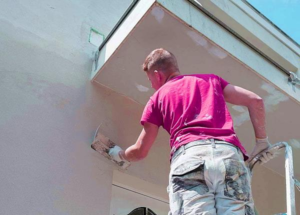The first step of stucco remediation is to uncover any underlying issues contributing to the damage. This can be done by inspecting around windows for staining or deterioration of the underlying brick.
Removing stucco is a big job, and it can be dangerous for homeowners who don’t have experience with scaffolding or ladders. It requires several days and a lot of elbow grease. Contact Stucco Removal now!

Stucco is a durable, attractive siding option for homes, but it can also develop problems over time due to improper installation, aging, and moisture infiltration. If left unaddressed, these issues can lead to extensive damage that requires major stucco remediation. Fortunately, early detection can help homeowners identify problems and take steps to stop them from getting worse. Common signs of stucco damage include surface cracks that seem to be getting bigger, water spots or dampness, and the presence of mildew or mold.
Stucco repair is often a more cost-effective solution than a complete replacement, but it’s important to keep in mind that repairing stucco doesn’t necessarily fix the underlying problem that caused the damage in the first place. For example, if you have a leak in your stucco wall, it may be due to an improperly flashed window – something that was never corrected and is now causing damage to the sheathing and framing of your home.
The process of removing stucco is similar to the process of installing it. First, workers prepare the worksite by laying down tarps and erecting scaffolding as necessary. Then, they use a hammer to make a small hole in the stucco and then chip or pry it away with a chisel or crowbar. Next, they remove the underlying materials like wires and nails, and clean the walls before they begin to replaster them.
When the new stucco is applied, it is carefully matched to the existing color and texture of your home to ensure a seamless transition from old to new. It is also inspected for any underlying problems, such as substrate damage or moisture issues. These are addressed so that your new stucco will be as durable and long-lasting as possible.
If your stucco is damaged beyond repair or you simply want to change the appearance of your home, a full replacement is the best option. However, the good news is that if your stucco is properly repaired and re-installed, it should last for up to 80 years without requiring any further maintenance or repairs.
Repairs
Stucco repairs help homeowners maintain the value and beauty of their homes. Professional stucco repair contractors assess the condition of a home’s exterior stucco to determine the best course of action for repairs. The assessment typically includes checking for signs of moisture damage, such as mold growth or water staining. It also involves looking for structural problems such as rot or insect infestations. If the sheathing or framing is damaged, these problems must be repaired before beginning the stucco repair process.
Surface-level issues, such as cracks, can be addressed with a stucco patching service. However, patching won’t address underlying problems like moisture infiltration. Stucco remediation addresses these underlying issues by replastering the entire wall system. This is a much more extensive service and requires more skilled workers to perform.
Remediation services are recommended if you’re seeing any of the following signs that your stucco may need to be replaced:
Stucco can become brittle and crack as a result of poor installation or harsh environmental conditions. When this occurs, it’s important to address the problem immediately to prevent further damage to your house’s structure and its interior. Cracking can occur in several ways, including long thin cracks that run vertically. Cracks can also appear in one area, which is usually a sign of moisture damage.
Moisture penetration is another common issue that can cause damage to the stucco and other exterior materials on a home. Moisture penetration can be caused by improper curing, freeze-thaw cycles or weather conditions that result in expansion and contraction. This damage can lead to leaks, which can be expensive to fix.
If you’re seeing any of these signs, it’s important to contact a stucco company in your area right away. By addressing the issue promptly, you’ll be able to protect your home from costly and time-consuming repairs in the future.
The cost of remediation and/or repair will depend on the scope of work needed, but there are some general rules that can help you estimate the overall price. You’ll need to factor in the cost of labor, any extra tools that may be needed and the costs associated with cleaning up the jobsite. If the brick beneath the stucco is damaged, you’ll need to hire a junk removal company to clear the debris before continuing with your project.
Preparation
Removing stucco from a house built of brick can be tricky. It’s important that the brick underneath not be damaged and that the underlying wall is protected against moisture intrusion. It’s essential to hire an expert for a thorough inspection before starting this labor-intensive project. This can help prevent costly mistakes, like removing brick joists that aren’t structurally sound. A professional can make this assessment quickly and easily with the use of specialized tools.
In addition to inspecting your home’s walls, a specialist can also tell you whether the damage in question requires repair or remediation. Repairs are for minor issues that don’t have an underlying cause, while remediation is more in-depth and involves replastering the entire wall system.
It’s important to know the difference between these services in order to choose the right service for your home. Many homeowners assume that they need remediation when they see a few cracks, but in reality, this may be an indication of deeper structural issues within the wall system. Moisture intrusion is often a culprit, which is why it’s important to carefully inspect the area around windows and any other potential problem spots.
When attempting to remove stucco, it’s a good idea to hire a specialist to avoid damaging your home’s structure and exposing it to the elements. This can be a very time-consuming process, especially when the mesh wire used to hold the stucco on needs to be removed as well.
This can be a dangerous job for those who aren’t comfortable on scaffolding or don’t have the strength and endurance required for such a project. It’s essential to wear safety gear when working with power tools and be aware of the potential for dust, dirt, and other hazardous materials to become airborne.
It’s also important to prepare your worksite before beginning the demolition. This will include clearing the area and ensuring that it’s free of debris and obstructions. The worksite should be cleared of plant growth, loose paint, oil, grease, and any other contaminants. In some cases, a professional junk removal company will be needed to dispose of the construction debris.
Removal
When stucco starts deteriorating and is no longer protecting your home, it needs to be removed. This process is time consuming and expensive. However, it is an essential step if you want to protect the integrity of your house and avoid significant damage.
Stucco deteriorates due to poor installation, substrate damage, moisture issues, and age. The material is susceptible to mold and rot. In addition, cracking, crumbling, or water infiltration can cause serious structural problems for your home. This is why it’s essential to consult a professional for removal services. They can inspect your exterior walls for signs of damage and repair any issues before completing the removal process.
The removal process varies depending on the surface type and accessibility. Wood surfaces require specialized techniques to prevent damaging the underlying sheathing and framing. Brick surfaces are particularly delicate, requiring careful handling to prevent damage. Concrete surfaces also require specialized tools and equipment to remove without damaging the underlying structure.
To begin the removal process, workers will use a hammer to loosen and break apart the existing stucco. This is followed by a chisel or crowbar to pry away pieces of stucco. The goal is to create a medium-sized hole for the use of a circular saw. Once the hole is large enough, a saw can be used to quickly carve off chunks of siding.
Once all of the old stucco has been removed, a new layer can be applied to your home’s exterior walls. This can be done to restore the beauty of your home’s exterior or to replace it with a different material.
The last thing you want to do when renovating your home is to replace it with a new stucco façade. This is not only a costly process, but it can lead to significant problems in the future.
When you notice a crack in your stucco, it is important to act quickly. Cracks that go deeper than 1/16″ of an inch are a sign of serious structural damage and should be repaired as soon as possible. Also, look for gaps near windows and door frames. These spaces are perfect receptacles for excess humidity that can ruin your stucco.
